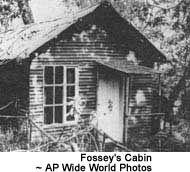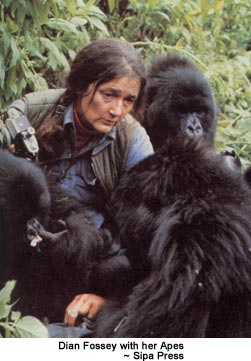"Queen of the Apes"
Dawn is enveloping Karisoke Research Station in the mist shrouded volcanic mountains along Rwanda's border with Uganda and Zaire. Suddenly, loud clamoring breaks the silence, and a group of wildly gesticulating black men storm into the cabin where the American graduate student Wayne McGuire is sleeping. With his limited knowledge of Swahili, he does not at first understand what they are saying, until a repeated phrase registers. "Dian kufa! Dian kufa! Dian is dead!" Running over to Dian Fossey's cabin, he finds her lifeless body sprawled next to the bed; her skull had been laid open by a diagonal cut from the forehead across the nose to the corner of her mouth. The weapon, a broad bladed knife used by forest workers to hack their way through underbrush - was one she had confiscated some years earlier from poachers. The cabin was in disarray, having been ransacked by the attacker or, perhaps, upset by Fossey in an attempt to ward off her assailant. Near the door stood a Christmas tree, with presents for the staff as yet undistributed. It was December 27, 1985.
Running over to Dian Fossey's cabin, he finds her lifeless body sprawled next to the bed; her skull had been laid open by a diagonal cut from the forehead across the nose to the corner of her mouth. The weapon, a broad bladed knife used by forest workers to hack their way through underbrush - was one she had confiscated some years earlier from poachers. The cabin was in disarray, having been ransacked by the attacker or, perhaps, upset by Fossey in an attempt to ward off her assailant. Near the door stood a Christmas tree, with presents for the staff as yet undistributed. It was December 27, 1985.Four days later, the dead woman was buried in the station's small animal cemetery, next to the graves of some of the gorillas to whom she had given her life. Nine months later, McGuire and one of the station employees, Emmanuel Rwelekana, were charged with the murder of the 54 year old Fossey. The native hanged himself, and McGuire, on the advice of the United States embassy in Rwanda, fled the country before he was arrested. Although he was tried and convicted in absentia, few if any accept his guilt. There were other, more obvious suspects.
 Dian Fossey was a far from uncontroversial person. Yet, her most intimate friends praised her as a warmhearted, thoroughly dedicated woman and called her "Queen of the Apes." Largely through her efforts, the East African mountain gorillas are no longer an endangered species. In Rwanda's Parc National des Volcans, at least 20 gorilla families live today; in the mid 1970's, there were only half as many.
Dian Fossey was a far from uncontroversial person. Yet, her most intimate friends praised her as a warmhearted, thoroughly dedicated woman and called her "Queen of the Apes." Largely through her efforts, the East African mountain gorillas are no longer an endangered species. In Rwanda's Parc National des Volcans, at least 20 gorilla families live today; in the mid 1970's, there were only half as many.With her research into the lifestyle and behavior of the giant beasts, Fossey refuted the Hollywood inspired myth of a fearsome, vicious King Kong. At first observing the gentle giants with the leathery faces from a safe distance, she eventually mingled among them by imitating their barking, grunting sounds and acquiring their unique body language. Thus, for example, she learned to brace her arms to signal friendliness and crouched so as never to appear larger than the family leader. In time, she was accepted by the animals almost as one of themselves and would sit for hours with them, nibbling on the wild celery they favored and being allowed to scratch and de-lice her research subjects.
The Road to East Africa
"Neither destiny nor fate took me to Africa," Fossey wrote. "Nor was it romance. I had a deep wish to see and live with wild animals in a world that hadn't yet been completely changed by humans." Her parents were divorced when she was six, and her stepfather kept her at arm's length. The lonely child sought friendship in animals but was denied all pets, except a goldfish; she cried for a week when it died.Fossey's plan to become a veterinarian ended when she failed to master chemistry and physics at the University of California at Davis. Instead, she became an occupational therapist and worked with physically and emotionally disabled children in a Louisville, Kentucky, hospital. Her interest in Africa was sparked by a young Rhodesian suitor, but she felt that marriage was too high a price to pay for a ticket to the Dark Continent. She started saving pennies for a trip and in 1963 left for East Africa.
In Tanzania she met the celebrated anthropologist Louis Leakey, who asked her what she still wanted to see. Told that her greatest hope was to see the mountain gorillas of the Virunga volcano country, Leakey asked if her interest in them was as a spectator or as a journalist. "Much more than that, Dr. Leakey," she replied. "Someday I plan to come here to live and work." A few days later, she saw her first gorillas. "They were big and imposing," she wrote, "but not monstrous at all. Somehow they looked more like members of a picnic party surprised by interlopers." When she left Africa, Fossey had no doubt that she would return to spend her life with the animals. Four years later, with a grant from the National Geographic Society, she established the Karisoke Research Station.
Scientific Research or Blind Infatuation
Nyiramachabelli, "lonely woman of the forest," is what the natives called her. She achieved much in her studies of the animals and can be credited with helping to save them from extinction. Yet, her motives and methods remained the subject of heated debate. Her highly personal relationship with the mountain gorillas surpassed both scholarly interest and the normal affection most people feel for animals. In sharp contrast to her love for the gorillas was her implacable hatred for the poachers who were destroying their habitat and wantonly slaying the beasts. She pursued them relentlessly, confiscating their tools and weapons and even flogging them personally.Soon she was at war not only with the poachers but also with Rwandan authorities, who were hoping to open the scenic volcanic park to tourism. Fossey was firmly opposed. Her gorillas were not zoo exhibits, and she threatened to shoot any tourist approaching her station. Such stubborn dedication in time earned her many enemies among them, no doubt, the unknown murderer who brutally killed her in December 1985.

